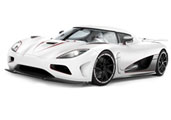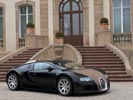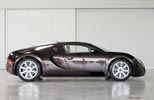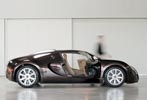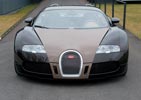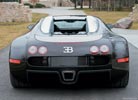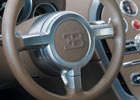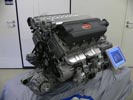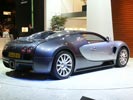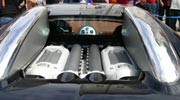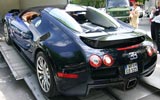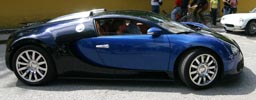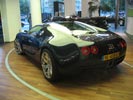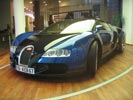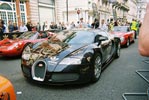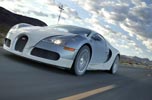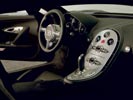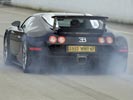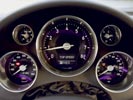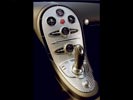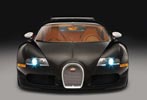The Bugatti Veyron 16.4 is the quickest accelerating and decelerating street-legal production car in the world, and was the world's fastest street-legal production car until the introduction of the SSC Ultimate Aero Twin Turbo produced by Shelby SuperCars.
Powered by a 1,001 PS (987 hp/736 kW) W16 engine, it is able to achieve an average top speed of 407.47 km/h (253.19 mph). The car reached full production in September 2005, and is handcrafted in a factory Volkswagen built near the former Bugatti headquarters in Château St Jean in Molsheim (Alsace, France). It is named after French racing driver Pierre Veyron, who won the 24 hours of Le Mans in 1939 while racing for the original Bugatti firm.
Development of this vehicle began with the 1999 EB 18/4 "Veyron" concept car which itself had a chassis based on that of the Bugatti 18/3 Chiron concept car. Introduced at the Tokyo Motor Show, it was similar in design and appearance to the final Veyron production car. One major difference was the EB 18/4's use of a W18 engine with three banks of six cylinders. The Veyron's head designer was Hartmut Warkuss with exterior designed by Jozef Kaba? of Volkswagen rather than Giorgetto Giugiaro of ItalDesign who had handled the three prior Bugatti concepts.
First seen in the 1999 Bentley Hunaudieres concept car, the W16 would get four turbochargers, producing a quoted (metric) 1001 horsepower (see engine section for details on the power output). Top speed was promised at 407 km/h (253 mph), and pricing was announced at 1 million pounds.
Bugatti originally planned to build 300 Veyrons over five years. Maintenance will be possible at Bugatti dealerships but repair service will require a flown-in mechanic, who the company promises will be available 24 hours a day.
The Sang Noir edition was inspired by the Bugatti Type 57 Atlantique. Most exterior details were painted black, including the fuel cap and the headlight assembly, while the front grille, side mirror casings, and the roof rails are chrome. Also, the central section of the body is clearcoated carbon fiber. The interior features black-piano lacquer trims.
On 10 September 2007 a special version of the Veyron called the Bugatti EB 16.4 Veyron "Pur Sang" was unveiled at the Frankfurt Motor Show. The difference from a standard Veyron is the body finishing: the Pur Sang has none. Instead it reveals the Veyron's pure aluminium-carbon fibre body. Pur Sang is French, meaning thoroughbred or pure blood (literally). Production will be limited to 5 cars. The car will be included with high-gloss aluminum wheels with a diamond cut finish.
At the Geneva motor show in 2008 Bugatti announced a partnership with the French fashion house Hermès. The Bugatti Veyron Fbg Par Hermès was the result. It features several new features as well as a redesigned front end. The interior is done in Hermès leather and it comes with a specially designed Hermès suitcase to fit in the trunk.
The Veyron features a W16 engine-16 cylinders in 4 banks of 4 cylinders, or the equivalent of two narrow-angle V8 engines mated in a "W" configuration. Each cylinder has 4 valves for a total of 64, but the narrow V8 configuration allows two camshafts to drive two banks of cylinders so only 4 camshafts are needed. The engine is fed by four turbochargers and displaces 8.0 L (7,993 cc/488 in³) with a square 86 mm (3.4 in) by 86 mm (3.4 in) bore and stroke.
Putting this power to the ground is a dual-clutch Direct-Shift Gearbox computer-controlled manual transmission with 7 gear ratios via shifter paddles behind the steering wheel boasting a less than 150 ms shift time, designed and manufactured by Ricardo of England. The Veyron can be driven by full automatic transmission. The Veyron also features full-time four-wheel drive based on the Haldex Traction system. It uses special Michelin run-flat tires designed specifically for the Veyron to accommodate the vehicle's top speed. Curb weight is estimated at 1,888 kg (4,160 lb). This gives the car a power to weight ratio of 529 bhp/ton.
The Bugatti Veyron has a total of 10 radiators.
Car - Bugatti Veyron
Copyright © 1998-2013 you.com.au

